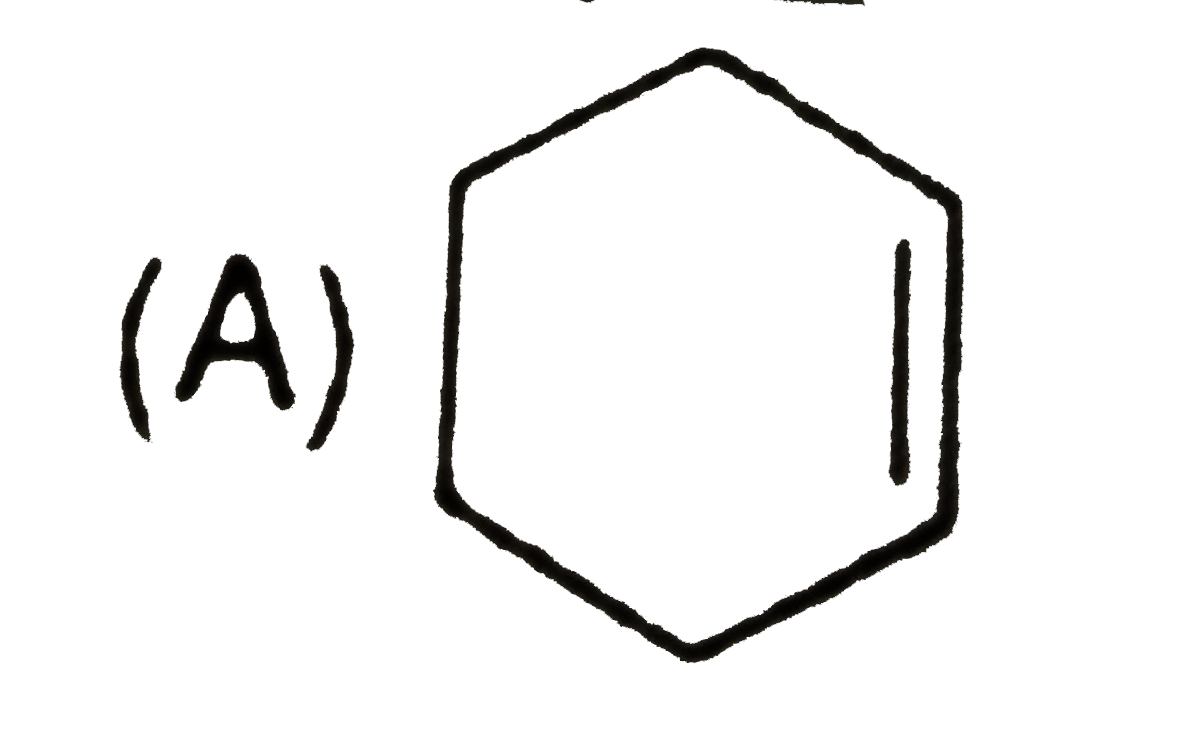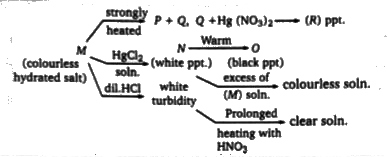A unsaturated hydrocarbons (P) on reductive ozonolysis produce an dicarbonyl compound (Q).(Q) can form precipitate with 2,4-DNP but no with Tollen's reagent. Identify the structure of P




The correct Answer is:D
To solve the problem step by step, we will analyze the information provided and identify the structures of the unsaturated hydrocarbon (P) and the dicarbonyl compound (Q).
Step 1: Understanding the Reaction
The problem states that an unsaturated hydrocarbon (P) undergoes reductive ozonolysis to produce a dicarbonyl compound (Q). Reductive ozonolysis typically cleaves double bonds in alkenes to form carbonyl compounds (aldehydes or ketones).
Step 2: Analyzing Compound Q
We know that compound Q can form a precipitate with 2,4-DNP (2,4-dinitrophenylhydrazine), which indicates that Q is a carbonyl compound (either an aldehyde or a ketone). However, Q does not react with Tollen's reagent, which is used to test for aldehydes. This means that Q must be a ketone, as ketones do not react with Tollen's reagent.
Step 3: Identifying the Structure of Q
Since Q is a ketone, we can represent it as RC(=O)R', where R and R' are hydrocarbon chains or groups.
Step 4: Analyzing Compound P
Next, we need to identify the structure of the unsaturated hydrocarbon P that would yield the ketone Q upon ozonolysis. The ozonolysis of an alkene typically results in the formation of carbonyl compounds at the sites of the double bond.
Step 5: Evaluating Possible Structures for P
We will evaluate the possible structures of P based on the information given:
1. Option A: A cyclic compound with a double bond. This would likely produce two carbonyl groups upon ozonolysis, which would lead to a compound that reacts with both 2,4-DNP and Tollen's reagent, hence not fitting our criteria.
2. Option B: A compound with two cyclic rings connected by a double bond. This would also produce two aldehyde groups upon ozonolysis, which would react with both 2,4-DNP and Tollen's reagent, thus not fitting.
3. Option C: A compound with a bridge and a double bond. This would yield both an aldehyde and a ketone upon ozonolysis, which would react with 2,4-DNP and Tollen's reagent, hence not fitting.
4. Option D: A compound with two six-membered rings and a double bond. Upon ozonolysis, this would yield a ketone and would react positively with 2,4-DNP but not with Tollen's reagent, fitting our criteria perfectly.
Conclusion
Based on the analysis, the structure of the unsaturated hydrocarbon P is represented by Option D.
Summary of Steps
1. Identify that Q is a ketone since it reacts with 2,4-DNP but not with Tollen's reagent.
2. Analyze the possible structures of P based on the ozonolysis reaction.
3. Evaluate each option to determine which one produces a ketone that meets the criteria.
The problem states that an unsaturated hydrocarbon (P) undergoes reductive ozonolysis to produce a dicarbonyl compound (Q). Reductive ozonolysis typically cleaves double bonds in alkenes to form carbonyl compounds (aldehydes or ketones).
We know that compound Q can form a precipitate with 2,4-DNP (2,4-dinitrophenylhydrazine), which indicates that Q is a carbonyl compound (either an aldehyde or a ketone). However, Q does not react with Tollen's reagent, which is used to test for aldehydes. This means that Q must be a ketone, as ketones do not react with Tollen's reagent.
Since Q is a ketone, we can represent it as RC(=O)R', where R and R' are hydrocarbon chains or groups.
Next, we need to identify the structure of the unsaturated hydrocarbon P that would yield the ketone Q upon ozonolysis. The ozonolysis of an alkene typically results in the formation of carbonyl compounds at the sites of the double bond.
We will evaluate the possible structures of P based on the information given:
Based on the analysis, the structure of the unsaturated hydrocarbon P is represented by Option D.
1. Identify that Q is a ketone since it reacts with 2,4-DNP but not with Tollen's reagent.
2. Analyze the possible structures of P based on the ozonolysis reaction.
3. Evaluate each option to determine which one produces a ketone that meets the criteria.
Topper's Solved these Questions
- STRUCTURAL IDENTIFICATION & PRACTICAL ORGANIC CHEMISTRYBook:RESONANCE ENGLISHChapter:STRUCTURAL IDENTIFICATION & PRACTICAL ORGANIC CHEMISTRYExercise:Part-II INTEGER
Explore 8 Videos
- STRUCTURAL IDENTIFICATION & PRACTICAL ORGANIC CHEMISTRYBook:RESONANCE ENGLISHChapter:STRUCTURAL IDENTIFICATION & PRACTICAL ORGANIC CHEMISTRYExercise:Comprehension
Explore 4 Videos
- STRUCTURAL IDENTIFICATION & PRACTICAL ORGANIC CHEMISTRYBook:RESONANCE ENGLISHChapter:STRUCTURAL IDENTIFICATION & PRACTICAL ORGANIC CHEMISTRYExercise:Part-III Match the column
Explore 1 Video
- SOLID STATEBook:RESONANCE ENGLISHChapter:SOLID STATEExercise:Part- IV
Explore 21 Videos
- THERMODYNAMIC & THERMOCHEMISTRYBook:RESONANCE ENGLISHChapter:THERMODYNAMIC & THERMOCHEMISTRYExercise:INORGANIC CHEMISTRY(P-Block Elements)
Explore 26 Videos
Similar Questions

Q. The structure of compound P is:
View SolutionCompounds P(C6H10) does not have any geometrical isomer.On ozonolysis, two products R(C3H4O) and Q(C3H6O) are formed.R gives negative iodoform test while Q responds positively towards I2/NaOH solution.S, another isomer of P is an unsymetrical alkene and on ozonolysis produces T(C6H107) which also gives a yellow precipitate with l2/NaOH solution and also positive test with Tollen's reagent Which of the following does not represent any of the molecules amongst P,Q,R,S & T.
View Solution
Knowledge Check
A compound (A) C4H8Cl2 on hydrolysis gives a product (B) which forms a 2,4-DNP derivative, but does not reduce Tollen's reagent. The compound (A) has structure:
ACH3CH2CHClCH2ClBCH3CH2CC2CH3CCH3CH2CH2CHCl2DCH3CHClCHClCH3Unknown compound (A) C5H10O give positive test with 2,4 - DNP
but negative test with Tollen's reagent. It also give yellow precipitate with I2/NaOH . (A) is :A B
B C
C D
D
Two goes P and Q both decolourise aqueous bromine but only one of them gives white ppt. with Tollen's reagent. P and Q are likely to be :
AH2C=CH2andCH3−C≡C−CH3BHC≡CHandCH3−CH2−C≡CHCHC≡CHandCH3−C≡CHDCH3−CH2−C≡CHandCH3−C≡C−CH3
An unsaturated hydrocarbon 'A' adds two molecules of H2 and on reductive ozonolysis gives butane-1, 4-dial, ethanal and propanone. Give the structure of 'A' , write its IUPAC name and explain the reactions involved.
View SolutionCompound (P) forms a precipitate with AgNO3. The precipitate dissolves in excess reagent (P). (P) cannot be:
View SolutionObserve the following sequence of reations

P shows geometrical isomersm.Q gives positive Tollen's test and the oxidation product of Tollen's test followed by acidification is the strongest acid among its all position isomers. R gives positive lab tests with 2,4-DNP, Fehling solution and I2/NaOH reagents.
Identify the structure of R.
View SolutionAn organic compound (P) on reductive ozonolysis gives one mole each of acetaldehyde, formaldehyde and carbon dioxide, the compound can be
View SolutionObserve the following sequence of reations

P shows geometrical isomersm.Q gives positive Tollen's test and the oxidation product of Tollen's test followed by acidification is the strongest acid among its all position isomers. R gives positive lab tests with 2,4-DNP, Fehling solution and I2/NaOH reagents.
What could be the structure of Q ?
View Solution
